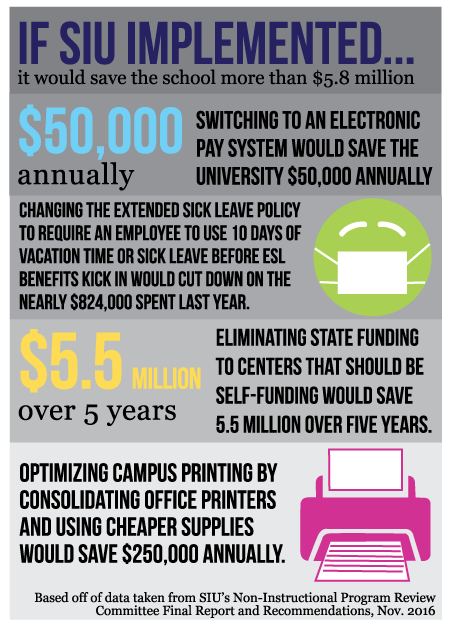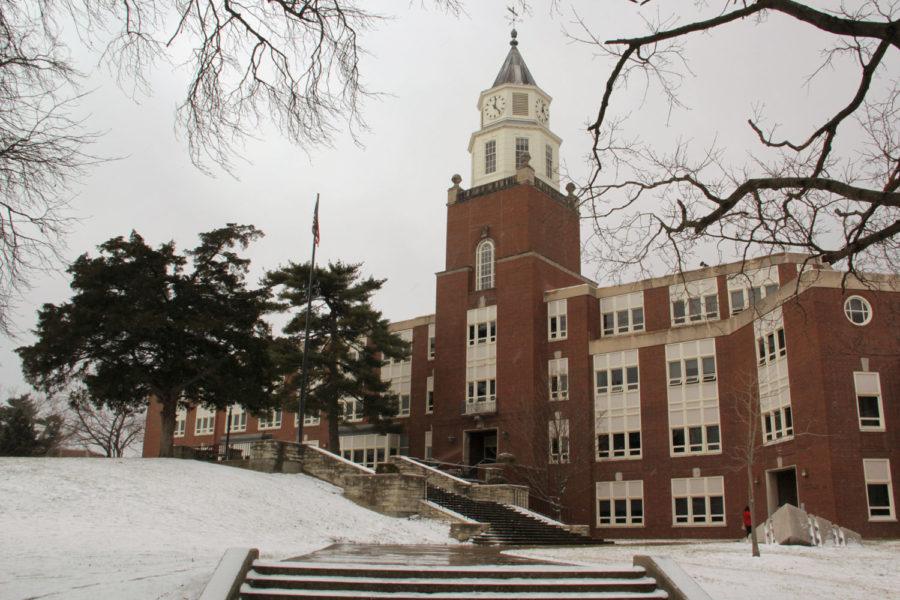If the budget crisis is not resolved by July, SIU will be ‘running on fumes,’ university president says
January 17, 2017
Unless the state budget impasse ends and significant funding begins to flow to the university by the end of the fiscal year in June, some university programs may see dramatic funding cuts.
The university broadcasting service, counseling and psychological services, the University Museum and university farms are among the groups at risk.
“If we just start doing away with those things I’m afraid we’ll never get them back,” SIU President Randy Dunn said Friday. “They’re a part of our history and what makes SIU Carbondale a special campus.”
Advertisement
Stopgap funding ended Jan. 1, and with a new session of the Illinois General Assembly in its second week and no end to the ongoing budget impasse in sight, SIU officials are singing a familiar tune.
“We’re right back in the same boat we were in this time last year when this budget situation started,” Dunn said.
In 2016, two stopgap measures passed through the state Legislature that totaled $83 million in support for the university.
For the most part, the stopgap funding was used to pay the bills from the 2016 fiscal year. The university started the 2017 fiscal year “basically back at zero” and is dipping into the reserves once again, Dunn said.
Though the university is not in a position where closure is being considered, Dunn said it would be difficult for SIU to continue functioning for another 18 months without having to “dismantle big parts of the university operation.”
Should no appropriations be made by the end of the fiscal year on June 30, he said SIU would be “running on fumes.”
Dunn said initial cuts would come from the findings of the non-academic prioritization committee appointed by interim Chancellor Brad Colwell. The report, released Thursday, focused on long term cash saving measures.
Advertisement*
Though long term efficiencies were the top priority, immediate savings were also part of the findings, SIU spokesperson and committee co-chairwoman Rae Goldsmith said.
Judy Marshall, executive director for finance and the committee’s other co-chair, said implementation of some of the report recommendations are already underway.
One example is an automated employee hiring service called HireTouch and switching to direct deposit to pay vendors. Though these may not seem like a major cost saving areas, “time is money” and streamlining some procedures would allow staff to focus on other things, Goldsmith said.
By eliminating costs associated with checks to vendors getting lost in the mail and having to be reissued, electronic payments would save the university more than $50,000 after full implementation, according to the report.
But Marshall said she was unable to estimate how long it would take to switch from paper to electronic checks because the process would require cooperation from vendors and participation would be voluntary.
More areas expected to receive cuts in the near future are centers or initiatives “that should be self-supporting,” the report says.
The report recommends completely eliminating state funding from the university broadcasting service, counseling and psychological services, the University Museum and university farms by 2022. This could save SIU $5.5 million over the course of five years, according to the report.
This initiative is still under consideration, Marshall said. The Chancellor’s Planning and Budget Advisory Council will review and prioritize the recommendations and deliver a report to Colwell by Feb. 1, Goldsmith said.
The first council meeting was Tuesday and a second will follow on Friday.
Other recommendations from the report are not yet underway, but would be “fairly easily implemented,” Goldsmith said.
These strategies include paying state rates for hotels used by traveling university employees and making travel arrangements far in advance because last-minute rates tend to be higher.
A “print analysis and optimization initiative” outlined in the report could potentially save the university $250,000 a year by switching to a cheaper toner, cutting down on printer models and reducing wasteful printing habits. This is another recommendation that could be put into use easily, Marshall said.
Even with these cuts and reductions, the university is “relying on lawmakers to come together and provide a budget for the university,” said John Charles, SIU’s executive director for governmental and public affairs.
Charles said the university system has the means to make it through the spring 2017 semester until the end of the fiscal year on June 30. After that point, he said, evaluations are needed to determine what additional cuts, if any, would be necessary to move forward.
Illinois public universities are asking the state Legislature to be funded at the same level as fiscal year 2015. For SIU, that was $199.5 million. The university system has received $106 million this fiscal year, which brings the request to an additional $93 million.
Charles said he is not entirely confident SIU will receive that amount. But there is a “renewed sense of cooperation” in the General Assembly, he said, and budget talks have placed higher education on the forefront.
Even if the full appropriation is given to the university, Charles said it will take longer than just one year before SIU is back on its feet.
“It’s going to require a long term commitment on behalf of our lawmakers,” Charles said. “That’s a partnership that we would need to work together on.”
Staff writer Marnie Leonard can be reached at mleonard@dailyegyptian.com or on Twitter @marsuzleo.
To stay up to date with all your southern Illinois news, follow the Daily Egyptian on Facebook and Twitter.
Advertisement









Addison • Jan 20, 2017 at 12:16 am
How about turning off some lights at night. For example, the library closes at 10pm but is fully lit all night long. Or, to start a tired argument, why aren’t we talking about cutting athletics instead of the university museum? The Museum is down to two employees and maybe 4 GA positions, and even if there was no programming the school is legally obligated to maintain the 70,000+ artifacts until they can be transferred to an appropriate facility, which is a bit more specialized than what can happen to most state property such as furniture. This process would literally take years. I’m willing to bet closing the football stadium would easily save the equivalent of the museum’s yearly budget many times over, and more faithfully serve the school’s purposes as a research institution.